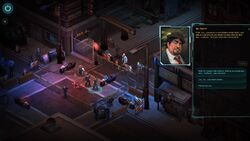RPG Codex Review: Vampire: The Masquerade - Redemption
RPG Codex Review: Vampire: The Masquerade - Redemption
Review - posted by Crooked Bee on Thu 30 October 2014, 15:01:00
Tags: Activision; Nihilistic Software; Vampire the Masquerade - RedemptionOne game the Codex never got around to reviewing is Nihilistic Software's Vampire: The Masquerade - Redemption, published by Activision in 2000 (and currently available from GOG.com). Compared to the much more celebrated Bloodlines, Redemption has fallen into relative obscurity and isn't generally considered a very good game. In this special Halloween feature, esteemed community member Deuce Traveler considers whether that reputation is deserved. (Spoiler: he thinks it is.) In the conclusion, another esteemed Codexer, felipepepe, offers a brief addendum on the game's Storyteller Mode.
Here's an excerpt to get you started:
Read the full article: RPG Codex Review: Vampire: The Masquerade - Redemption
Here's an excerpt to get you started:
Another gripe that I have with Redemption is its lack of adherence to the Vampire: The Masquerade lore. The events that Christof is involved with in medieval times eventually result in an Inquisition against the vampire lords, but the timeline doesn't quite seem to match White Wolf's publications. Also, the clan of vampire you are born into dictates the set of disciplines (related categories of vampire powers) available to you in the tabletop version, but in the video game your party can run into books which impart upon the reader new vampire disciplines, like some sort of quick-read "Vampire Powers for Dummies" pamphlet.
I've played the tabletop version of the classic World of Darkness roleplaying game a handful of times, so while I'm not an expert, I know a bit about its Storyteller System ruleset. The Storyteller System was a d10 ruleset used by White Wolf for all of its World of Darkness titles, from Vampire: The Masquerade to Mage: The Ascension. The classic Vampire: The Masquerade rules that Redemption was based upon encouraged the use of skills for engaging in non-combat activities such as investigations and diplomacy. Often a group of Vampire players would investigate the activities of enemy Sabbat (the bad guys) agents infiltrating their city, or tread the interwoven politics of their own allied Camarilla (the supposed good guys). In Redemption, though, the designers went with the classic action RPG dungeon crawler formula, despite the fact that the Storyteller system was best suited for a less combat-oriented experience.
The game focuses on dungeon crawling and combat against larger numbers of vampires than would be reasonably expected to be residing in a single city. The skill system is completely tossed out - fighting is the only way of solving quests. There is also a bit of puzzle solving, which can be summed up as "find the hidden switch to open the next passageway". Instead of allowing you to explore the character of Christof and the world of which he is a part, the game takes the uninteresting Save The World route, without ever explaining how the big bad evil guy could take over the world when four vampires in trench coats can take him out easily enough.
I've played the tabletop version of the classic World of Darkness roleplaying game a handful of times, so while I'm not an expert, I know a bit about its Storyteller System ruleset. The Storyteller System was a d10 ruleset used by White Wolf for all of its World of Darkness titles, from Vampire: The Masquerade to Mage: The Ascension. The classic Vampire: The Masquerade rules that Redemption was based upon encouraged the use of skills for engaging in non-combat activities such as investigations and diplomacy. Often a group of Vampire players would investigate the activities of enemy Sabbat (the bad guys) agents infiltrating their city, or tread the interwoven politics of their own allied Camarilla (the supposed good guys). In Redemption, though, the designers went with the classic action RPG dungeon crawler formula, despite the fact that the Storyteller system was best suited for a less combat-oriented experience.
The game focuses on dungeon crawling and combat against larger numbers of vampires than would be reasonably expected to be residing in a single city. The skill system is completely tossed out - fighting is the only way of solving quests. There is also a bit of puzzle solving, which can be summed up as "find the hidden switch to open the next passageway". Instead of allowing you to explore the character of Christof and the world of which he is a part, the game takes the uninteresting Save The World route, without ever explaining how the big bad evil guy could take over the world when four vampires in trench coats can take him out easily enough.
Read the full article: RPG Codex Review: Vampire: The Masquerade - Redemption
[Review by Deuce Traveler; edited by Infinitron]
One game the Codex never got around to reviewing is Nihilistic Software's Vampire: The Masquerade - Redemption, published in 2000 by Activision. Compared to the much more celebrated Bloodlines, Redemption has fallen into relative obscurity and isn't generally considered a very good game. Is this reputation deserved? Read on to find out.
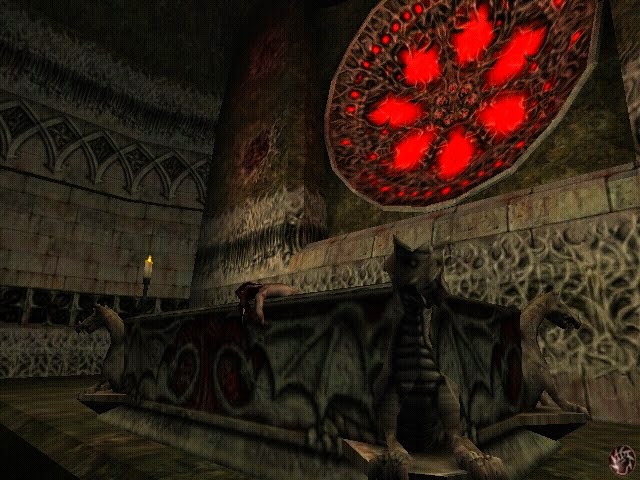
It's Halloween time, a time of year which I usually spend playing horror-themed titles. Most people at RPG Codex laud Troika's Vampire: The Masquerade - Bloodlines, but rarely speak about its older predecessor, Nihilistic Software’s Vampire: The Masquerade - Redemption. Seeing as how I picked the game up on GOG a while back, and Halloween is fast approaching, I decided to give it a go and find out why. (To be honest, I actually picked up a physical copy of Redemption in a bargain bin over a decade ago and became stuck in a game-breaking bug a few hours in. At least I got to return to the game and finally beat it. But I get ahead of myself.)
The game's story deals with a young crusader named Christof who is critically wounded while fighting against European pagan forces, and left in a Prague convent to be nursed to health by a nun named Anezka. The city is besieged by monsters during the night, and the recovering Christof must help the city and Anezka, whom he begins to have strong feelings towards. The plot of the game is driven by Christof's and Anezka's suppressed passion. Before some of you roll your eyes, let me say that this plotline is a perfect parallel to Christof learning to accept his soon-to-be-inflicted vampirism.
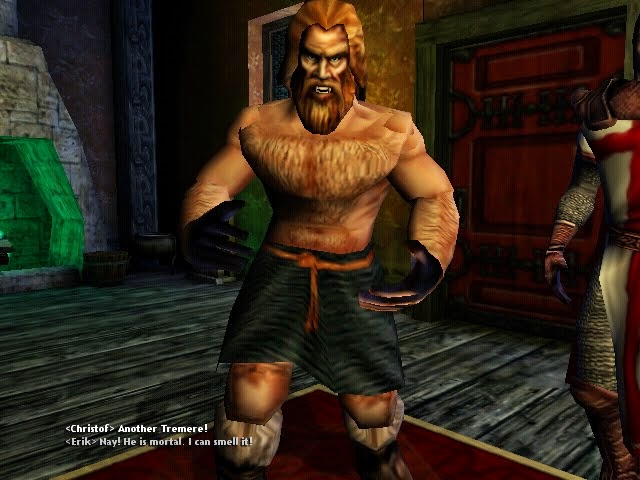
Anezka has taken a vow of chastity and has devoted herself to God, and Christof is also a devout believer fighting to spread his faith. Both Anezka and Christof understand that to consummate their feelings would damn them. To prevent this fate, Christof runs out on Anezka and into the unsafe Prague night, where he is embraced by a vampiress and made a vassal. In turn, Anezka realizes that Christof suffered due to his love for her, and so she forsakes everything in order to find him and try to turn him back to God’s grace.
The rest of the game revolves around the two would-be lovers in their attempts to save one another over the course of over 800 years. Anezka suffers through this separation for centuries, while Christof is put into a sleep-like state called a torpor for the majority of that time (a fact that makes him near legendary in the game's lore, a transition which is a bit jarring for the player). Anezka and Christof's relationship directly parallels the lore of classic Vampire: The Masquerade, where vampires are always struggling with their humanity; either finally finding some peace in undeath, or eventually succumbing to their more bloodthirsty natures.
The voice actor who portrays Christof plays his role straight and convincingly, while Anezka is not just some McGuffin with legs, but an important character who propels the story forward from behind the scenes. It's just too bad that so much of the rest of the game fails.
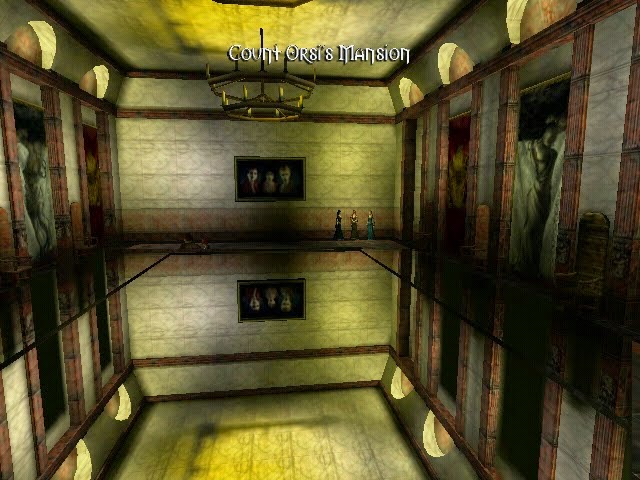
As stated, Redemption starts in 12th century Prague. The developers got some of the details of the city correct, such as the castle being located in the north-west of the city and the inclusion of Judith Bridge, but other than that, its depiction is rather lifeless. The buildings are undetailed and amateurish-looking, while almost all NPCs can only be interacted with by attacking them or draining them of blood. All of the other cities in the game (both medieval and modern) are the same, with only cosmetic changes to the guards/police and citizens distinguishing between them. My frustration with this may be stronger since I've personally spent time in each of the cities depicted in the game, and at no point does it succeed in reflecting an accurate feeling of what it feels like to be there.
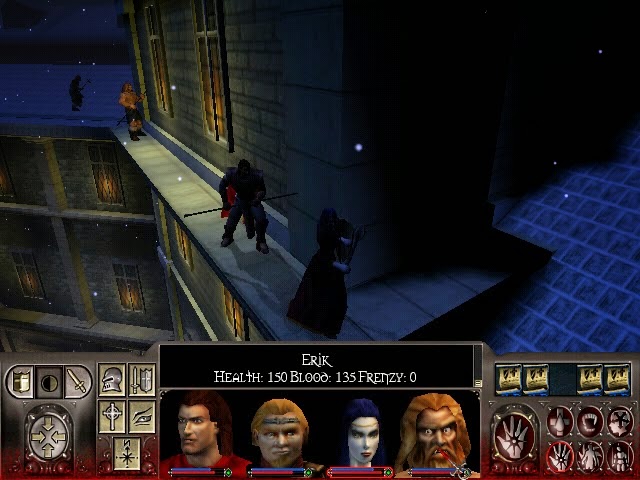
Another gripe that I have with Redemption is its lack of adherence to the Vampire: The Masquerade lore. The events that Christof is involved with in medieval times eventually result in an Inquisition against the vampire lords, but the timeline doesn't quite seem to match White Wolf's publications. Also, the clan of vampire you are born into dictates the set of disciplines (related categories of vampire powers) available to you in the tabletop version, but in the video game your party can run into books which impart upon the reader new vampire disciplines, like some sort of quick-read "Vampire Powers for Dummies" pamphlet.
I've played the tabletop version of the classic World of Darkness roleplaying game a handful of times, so while I'm not an expert, I know a bit about its Storyteller System ruleset. The Storyteller System was a d10 ruleset used by White Wolf for all of its World of Darkness titles, from Vampire: The Masquerade to Mage: The Ascension. The classic Vampire: The Masquerade rules that Redemption was based upon encouraged the use of skills for engaging in non-combat activities such as investigations and diplomacy. Often a group of Vampire players would investigate the activities of enemy Sabbat (the bad guys) agents infiltrating their city, or tread the interwoven politics of their own allied Camarilla (the supposed good guys). In Redemption, though, the designers went with the classic action RPG dungeon crawler formula, despite the fact that the Storyteller system was best suited for a less combat-oriented experience.
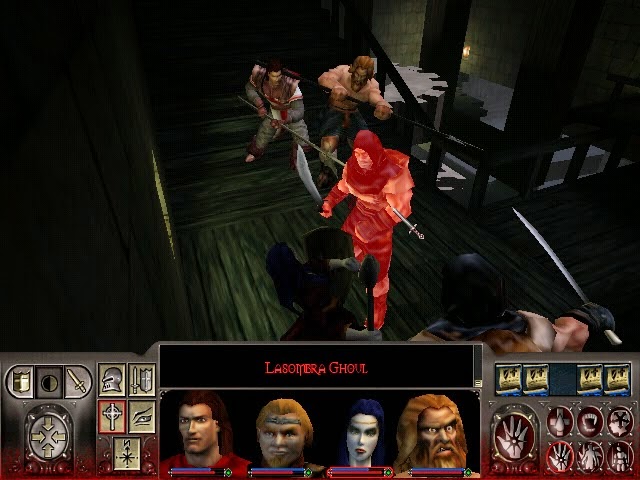
The game focuses on dungeon crawling and combat against larger numbers of vampires than would be reasonably expected to be residing in a single city. The skill system is completely tossed out - fighting is the only way of solving quests. There is also a bit of puzzle solving, which can be summed up as "find the hidden switch to open the next passageway". Instead of allowing you to explore the character of Christof and the world of which he is a part, the game takes the uninteresting Save The World route, without ever explaining how the big bad evil guy could take over the world when four vampires in trench coats can take him out easily enough.
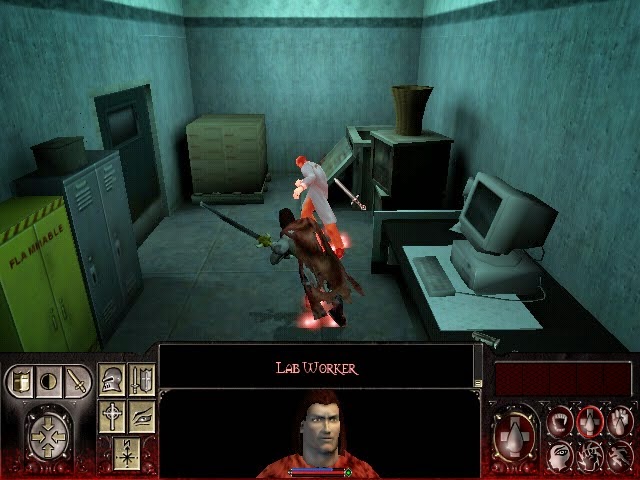
There isn't really any proper choice and consequence in this game, although there are multiple conversations in which you get to choose between a 'good' answer and a 'bad' answer, which might affect your humanity score. You have to maintain your humanity score in order to achieve the 'best' ending, but the game is excruciatingly linear and will push you along no matter what dialogue options you pick. Start expressing doubts over the wisdom of pursuing Anezka? You’ll pursue her anyway. Choose to spare an encountered villain? He’ll die anyway. Towards the end of the game, I asked a trio of vampiresses where the Big Bad Evil Guy was hiding, and they refused to answer. My only options were either letting them go, or threatening them. I decided to just walk away because it was obviously the 'good' answer, and moved by my compassion, the evil trio spilled the beans on their entire operation. Derp.
The game's interface is rage-inducing. In theory, it should be easy to handle since most interactions just use the left mouse button. Want your party to walk to the other side of the street? Left click there. Want to pick something up? Move the mouse over it and left click. Want to attack or talk to someone? Mouse over to them and left click. Simple and easy enough - except when you're trying to move your party and accidentally left click a random passerby who happened to walk past your mouse cursor at the exact wrong moment, resulting in your character and teammates initiating combat with a random hobo. Said hobo screams before he dies, which alerts all the local police, and suddenly you are in a large and completely unintended battle, and about to lose a ton of humanity points due to all the unintended civilian deaths.
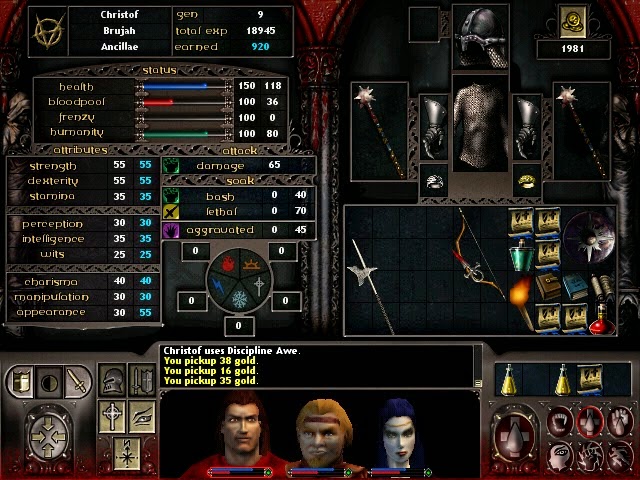
Do you want to send one character past a trap, but leave the others behind until said trap can be deactivated? To do so you have to click this tiny patch of green pixels next to each character's icon, which disables their follow mode, click where you want your active character to go, then click another button so the party follows you again, for a total of six mouse clicks. And you'd better hope there are no enemies waiting on the other side, because they’ll get a bunch of free pot shots at you while you’re trying to click on the tiny trap. Oh, and a lot of the traps are bugged to hell. I experienced one awesomely bugged trap that caused a gigantic, swinging hammer of death to be stuck permanently in the up position, making me think it was safe to cross. But when I attempted to walk by, some unseen force killed me every time - the game must have been registering the hammer in the down and swinging position.
When you attack, if you have the follow modes activated, your entire party will attack the individual you are engaging, unless another enemy obstructs them. Then they might attack the person blocking them, or maybe they'll just run in place instead. Thankfully, the same sometimes goes for your enemies. It is not unusual to see the bad guys politely standing in a short line and waiting their turn as you hack them down one by one. The best part is when your allies or enemies attack with area of effect weapons and blow up folks on their own side. It's like Christof is the World of Darkness' version of Luke Wilson's character from Idiocracy, waking up after centuries of slumber to discover the world has become populated by morons.

The game's real challenge is not in fighting enemies, but in using the interface. I could, in theory, have each of my characters doing something cool in combat. Maybe I want two guys to engage in melee against two different foes, another to toss a fireball, and the fourth to use a mental effect. That wouldn't be a problem in most games, but in this game your party members glue themselves to the currently active character at all times. If I select my first melee fighter and move him to a choke point to block some incoming enemies, then all of his allies will follow him. If I select my second melee fighter and position him to defend the flank, all of the other party members, including the first melee fighter, will start moving towards him, undoing the first fighter's actions. I could disable the party members' follow modes, but then they would all just sit there if my active character was attacked, forcing me to select them one by one and give them orders while the real-time combat unfolded around me. I could probably still manage that if the game had an active pause, but unfortunately its combat is completely real-time. Even thinking about this insanity is enough to make me want to punch a random game developer. There were times when I disabled the follow mode for the entire party and had Christof run through a dungeon level all by himself because it was safer for his companions and easier on me. Actually, Christof became a one-vampire army for me by the end of the game. Fun fact: If you take a moment to examine his character arc, you'll notice that he starts off as a weak vampire, but slaughters his way to the top of the food chain and becomes one of the strongest vampires in the game - despite only being conscious for maybe a couple of months out of his entire 800-year lifespan.
I prefer party-based games over single character ones, but in this case the game would probably have been better with a single character. Handling a party of two isn't bad, but when you get to four characters and try to fight in tight corridors, they end up tripping all over each other, to the understandable glee of enemy snipers. And I don't even know why these yahoos are in my party. Sure, one character joins because he has a life debt to Christof, but the others tag along because they just kinda like him and he might have helped a few out a little. They must be the most altruistic bloodsuckers one will ever meet in the World of Darkness, since they are told numerous times that they are facing suicide missions. I also like how you find a blood-bonded vampiress named Lily who begs you to fight the one she is bonded to so that she might be free. You agree to help, take her with you around the city for supplies several times, and she even helps you attack the one to which she is bonded. How does that blood bond work again?
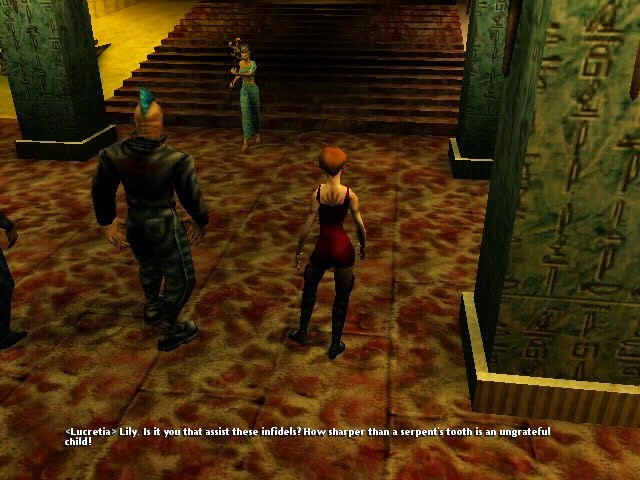
Another infuriating element of the game's combat is how easy it is for enemies to survive combat and re-attack the party. Every time an enemy is badly injured he will attempt to shuffle away. Melee attacks take so long to complete that the fleeing enemy will usually quickly be out of range of all but the longest weapons. This resulted in my characters often finding themselves randomly chasing one dude around a room while the other vampires in the enemy group hit them from afar. And it's not like I could just let the injured vampire run away, since he'd just heal himself and start shooting at me again from a corner. Because of this, I found it better to equip everyone with longer range weapons like halberds and pikes when clearing rooms. The modern portion of the game was easier, because the game gives you ballistic ranged weapons, but as far as bows go, I found their arrows so slow that they often completely missed walking enemies. Back attacks also seemed more effective than frontal attacks, which if true is a nice feature in an otherwise horrible combat system.

Despite not enjoying the combat, I do have a guilty confession. I must admit, there was something undeniably fun about playing a woken vampire dressed in crusader armor and wielding a two-handed, blood-draining sword, hacking at unarmored scientists in the modern era. It was a small joy in an otherwise joyless experience. By the way, this game won the 1999 Game Critics Awards at E3 for its genre. Which is amazing since it wasn't released until midway into 2000, and 1999 saw the release of CRPGs such as Jagged Alliance 2, System Shock 2 and Planescape: Torment. The mind boggles.
Myself, I would say avoid this title, or just watch a Let's Play of it on YouTube. Christof and Anezka are interesting characters, as is their romantic subplot. But the game's interface is poorly conceived, the combat is clunky, the scenery is bland, and the Masquerade mythos misused and butchered. I can't even get too angry about this game because it's actually too bland and boring to elicit emotion. I've never played Vampire: the Masquerade - Bloodlines, but I'm hoping it's better than this dreck. Honestly, I can't see how it could be worse. Don't waste your time here, folks. There are better games out there to play this Halloween.
Addendum: Storyteller Mode
[Written by felipepepe]
Vampire: The Masquerade - Redemption may not inspire much devotion, but it has one key element that by itself deserves respect, even if more for the concept than the execution. Two years before Neverwinter Nights, Redemption presented CRPG players with the Storyteller mode, a multiplayer mode where 3 players could go on adventures, while a fourth player could act as the GM of the campaign, talking with players, controlling monsters and overall directing the show. This was a pet project for the developers, who were determined to offer something new:
However, as amazing as that sounds, the Storyteller Mode fails horribly in its task. While it works well for the three players, the GM will suffer to get anything done. As a GM, there are very few tools at your disposal, and they are all horribly slow and awkward to use. For example, you cannot place assets and props away from you – if you want to place an enemy at the end of an alleyway you must physically move your GM avatar (a giant bald head) to that spot and then spawn the enemy where you stand, or spawn it elsewhere, "possess" the creature and walk it to the desired location. This makes things too clunky to change on the fly, so you must either set up a very well planned map and just activate things as players go, or rely heavily on asking players to wait while you awkwardly change things with your giant floating head... and you'd better ask them politely, because while you can pause the game as a GM, you also become paused and unable to move!

Moreover, the only way to play Storyteller Mode over the internet was using WON.net, one of those late 90s online gaming hubs. WON.net quickly went down when the online bubble burst (it was eaten byGabeN Valve in 2001), and gone was the ability to play VtM:Redemption online. Even the latest GOG version of the game still tries to connect to WON.net when you click "Internet Game", so your only choice is playing on LAN, or using "online LAN" websites such as Tunngle.
The tools for creating new content are very unfriendly as well. They weren't designed for regular players to easily pick up and make their own stuff, like the Aurora Toolset. Simple actions such as changing the properties of an item require you to download the game's SDK and use an Excel-like editor to directly alter the game's files. And the only way to create new areas is to use separate software called Embrace, based on Quake's Qradiant level design tool. The game only came with two very short multiplayer campaigns, but there is a vast amount of fan-made maps & skins available at http://e-mods.net/.
To be honest, Redemption's Storyteller Mode is just a curiosity today, an obscure pioneer that became outdated the moment that NWN and the Aurora Toolset arrived. But if you absolutely must play it, the Age of Redemption 2014 Mod allows you to play the main campaign in co-op with friends, with the option of having a GM to spice things up. I personally recommend gathering some friends, along with lots of alcohol and a troll GM – the sober atmosphere of the tabletop Vampire: The Masquerade game has no place here.
You can buy Vampire: The Masquerade - Redemption on GOG.com.
One game the Codex never got around to reviewing is Nihilistic Software's Vampire: The Masquerade - Redemption, published in 2000 by Activision. Compared to the much more celebrated Bloodlines, Redemption has fallen into relative obscurity and isn't generally considered a very good game. Is this reputation deserved? Read on to find out.

It's Halloween time, a time of year which I usually spend playing horror-themed titles. Most people at RPG Codex laud Troika's Vampire: The Masquerade - Bloodlines, but rarely speak about its older predecessor, Nihilistic Software’s Vampire: The Masquerade - Redemption. Seeing as how I picked the game up on GOG a while back, and Halloween is fast approaching, I decided to give it a go and find out why. (To be honest, I actually picked up a physical copy of Redemption in a bargain bin over a decade ago and became stuck in a game-breaking bug a few hours in. At least I got to return to the game and finally beat it. But I get ahead of myself.)
The game's story deals with a young crusader named Christof who is critically wounded while fighting against European pagan forces, and left in a Prague convent to be nursed to health by a nun named Anezka. The city is besieged by monsters during the night, and the recovering Christof must help the city and Anezka, whom he begins to have strong feelings towards. The plot of the game is driven by Christof's and Anezka's suppressed passion. Before some of you roll your eyes, let me say that this plotline is a perfect parallel to Christof learning to accept his soon-to-be-inflicted vampirism.

Anezka has taken a vow of chastity and has devoted herself to God, and Christof is also a devout believer fighting to spread his faith. Both Anezka and Christof understand that to consummate their feelings would damn them. To prevent this fate, Christof runs out on Anezka and into the unsafe Prague night, where he is embraced by a vampiress and made a vassal. In turn, Anezka realizes that Christof suffered due to his love for her, and so she forsakes everything in order to find him and try to turn him back to God’s grace.
The rest of the game revolves around the two would-be lovers in their attempts to save one another over the course of over 800 years. Anezka suffers through this separation for centuries, while Christof is put into a sleep-like state called a torpor for the majority of that time (a fact that makes him near legendary in the game's lore, a transition which is a bit jarring for the player). Anezka and Christof's relationship directly parallels the lore of classic Vampire: The Masquerade, where vampires are always struggling with their humanity; either finally finding some peace in undeath, or eventually succumbing to their more bloodthirsty natures.
The voice actor who portrays Christof plays his role straight and convincingly, while Anezka is not just some McGuffin with legs, but an important character who propels the story forward from behind the scenes. It's just too bad that so much of the rest of the game fails.

As stated, Redemption starts in 12th century Prague. The developers got some of the details of the city correct, such as the castle being located in the north-west of the city and the inclusion of Judith Bridge, but other than that, its depiction is rather lifeless. The buildings are undetailed and amateurish-looking, while almost all NPCs can only be interacted with by attacking them or draining them of blood. All of the other cities in the game (both medieval and modern) are the same, with only cosmetic changes to the guards/police and citizens distinguishing between them. My frustration with this may be stronger since I've personally spent time in each of the cities depicted in the game, and at no point does it succeed in reflecting an accurate feeling of what it feels like to be there.

Another gripe that I have with Redemption is its lack of adherence to the Vampire: The Masquerade lore. The events that Christof is involved with in medieval times eventually result in an Inquisition against the vampire lords, but the timeline doesn't quite seem to match White Wolf's publications. Also, the clan of vampire you are born into dictates the set of disciplines (related categories of vampire powers) available to you in the tabletop version, but in the video game your party can run into books which impart upon the reader new vampire disciplines, like some sort of quick-read "Vampire Powers for Dummies" pamphlet.
I've played the tabletop version of the classic World of Darkness roleplaying game a handful of times, so while I'm not an expert, I know a bit about its Storyteller System ruleset. The Storyteller System was a d10 ruleset used by White Wolf for all of its World of Darkness titles, from Vampire: The Masquerade to Mage: The Ascension. The classic Vampire: The Masquerade rules that Redemption was based upon encouraged the use of skills for engaging in non-combat activities such as investigations and diplomacy. Often a group of Vampire players would investigate the activities of enemy Sabbat (the bad guys) agents infiltrating their city, or tread the interwoven politics of their own allied Camarilla (the supposed good guys). In Redemption, though, the designers went with the classic action RPG dungeon crawler formula, despite the fact that the Storyteller system was best suited for a less combat-oriented experience.

The game focuses on dungeon crawling and combat against larger numbers of vampires than would be reasonably expected to be residing in a single city. The skill system is completely tossed out - fighting is the only way of solving quests. There is also a bit of puzzle solving, which can be summed up as "find the hidden switch to open the next passageway". Instead of allowing you to explore the character of Christof and the world of which he is a part, the game takes the uninteresting Save The World route, without ever explaining how the big bad evil guy could take over the world when four vampires in trench coats can take him out easily enough.

There isn't really any proper choice and consequence in this game, although there are multiple conversations in which you get to choose between a 'good' answer and a 'bad' answer, which might affect your humanity score. You have to maintain your humanity score in order to achieve the 'best' ending, but the game is excruciatingly linear and will push you along no matter what dialogue options you pick. Start expressing doubts over the wisdom of pursuing Anezka? You’ll pursue her anyway. Choose to spare an encountered villain? He’ll die anyway. Towards the end of the game, I asked a trio of vampiresses where the Big Bad Evil Guy was hiding, and they refused to answer. My only options were either letting them go, or threatening them. I decided to just walk away because it was obviously the 'good' answer, and moved by my compassion, the evil trio spilled the beans on their entire operation. Derp.
The game's interface is rage-inducing. In theory, it should be easy to handle since most interactions just use the left mouse button. Want your party to walk to the other side of the street? Left click there. Want to pick something up? Move the mouse over it and left click. Want to attack or talk to someone? Mouse over to them and left click. Simple and easy enough - except when you're trying to move your party and accidentally left click a random passerby who happened to walk past your mouse cursor at the exact wrong moment, resulting in your character and teammates initiating combat with a random hobo. Said hobo screams before he dies, which alerts all the local police, and suddenly you are in a large and completely unintended battle, and about to lose a ton of humanity points due to all the unintended civilian deaths.

Do you want to send one character past a trap, but leave the others behind until said trap can be deactivated? To do so you have to click this tiny patch of green pixels next to each character's icon, which disables their follow mode, click where you want your active character to go, then click another button so the party follows you again, for a total of six mouse clicks. And you'd better hope there are no enemies waiting on the other side, because they’ll get a bunch of free pot shots at you while you’re trying to click on the tiny trap. Oh, and a lot of the traps are bugged to hell. I experienced one awesomely bugged trap that caused a gigantic, swinging hammer of death to be stuck permanently in the up position, making me think it was safe to cross. But when I attempted to walk by, some unseen force killed me every time - the game must have been registering the hammer in the down and swinging position.
When you attack, if you have the follow modes activated, your entire party will attack the individual you are engaging, unless another enemy obstructs them. Then they might attack the person blocking them, or maybe they'll just run in place instead. Thankfully, the same sometimes goes for your enemies. It is not unusual to see the bad guys politely standing in a short line and waiting their turn as you hack them down one by one. The best part is when your allies or enemies attack with area of effect weapons and blow up folks on their own side. It's like Christof is the World of Darkness' version of Luke Wilson's character from Idiocracy, waking up after centuries of slumber to discover the world has become populated by morons.

The game's real challenge is not in fighting enemies, but in using the interface. I could, in theory, have each of my characters doing something cool in combat. Maybe I want two guys to engage in melee against two different foes, another to toss a fireball, and the fourth to use a mental effect. That wouldn't be a problem in most games, but in this game your party members glue themselves to the currently active character at all times. If I select my first melee fighter and move him to a choke point to block some incoming enemies, then all of his allies will follow him. If I select my second melee fighter and position him to defend the flank, all of the other party members, including the first melee fighter, will start moving towards him, undoing the first fighter's actions. I could disable the party members' follow modes, but then they would all just sit there if my active character was attacked, forcing me to select them one by one and give them orders while the real-time combat unfolded around me. I could probably still manage that if the game had an active pause, but unfortunately its combat is completely real-time. Even thinking about this insanity is enough to make me want to punch a random game developer. There were times when I disabled the follow mode for the entire party and had Christof run through a dungeon level all by himself because it was safer for his companions and easier on me. Actually, Christof became a one-vampire army for me by the end of the game. Fun fact: If you take a moment to examine his character arc, you'll notice that he starts off as a weak vampire, but slaughters his way to the top of the food chain and becomes one of the strongest vampires in the game - despite only being conscious for maybe a couple of months out of his entire 800-year lifespan.
I prefer party-based games over single character ones, but in this case the game would probably have been better with a single character. Handling a party of two isn't bad, but when you get to four characters and try to fight in tight corridors, they end up tripping all over each other, to the understandable glee of enemy snipers. And I don't even know why these yahoos are in my party. Sure, one character joins because he has a life debt to Christof, but the others tag along because they just kinda like him and he might have helped a few out a little. They must be the most altruistic bloodsuckers one will ever meet in the World of Darkness, since they are told numerous times that they are facing suicide missions. I also like how you find a blood-bonded vampiress named Lily who begs you to fight the one she is bonded to so that she might be free. You agree to help, take her with you around the city for supplies several times, and she even helps you attack the one to which she is bonded. How does that blood bond work again?

Another infuriating element of the game's combat is how easy it is for enemies to survive combat and re-attack the party. Every time an enemy is badly injured he will attempt to shuffle away. Melee attacks take so long to complete that the fleeing enemy will usually quickly be out of range of all but the longest weapons. This resulted in my characters often finding themselves randomly chasing one dude around a room while the other vampires in the enemy group hit them from afar. And it's not like I could just let the injured vampire run away, since he'd just heal himself and start shooting at me again from a corner. Because of this, I found it better to equip everyone with longer range weapons like halberds and pikes when clearing rooms. The modern portion of the game was easier, because the game gives you ballistic ranged weapons, but as far as bows go, I found their arrows so slow that they often completely missed walking enemies. Back attacks also seemed more effective than frontal attacks, which if true is a nice feature in an otherwise horrible combat system.

Despite not enjoying the combat, I do have a guilty confession. I must admit, there was something undeniably fun about playing a woken vampire dressed in crusader armor and wielding a two-handed, blood-draining sword, hacking at unarmored scientists in the modern era. It was a small joy in an otherwise joyless experience. By the way, this game won the 1999 Game Critics Awards at E3 for its genre. Which is amazing since it wasn't released until midway into 2000, and 1999 saw the release of CRPGs such as Jagged Alliance 2, System Shock 2 and Planescape: Torment. The mind boggles.
Myself, I would say avoid this title, or just watch a Let's Play of it on YouTube. Christof and Anezka are interesting characters, as is their romantic subplot. But the game's interface is poorly conceived, the combat is clunky, the scenery is bland, and the Masquerade mythos misused and butchered. I can't even get too angry about this game because it's actually too bland and boring to elicit emotion. I've never played Vampire: the Masquerade - Bloodlines, but I'm hoping it's better than this dreck. Honestly, I can't see how it could be worse. Don't waste your time here, folks. There are better games out there to play this Halloween.
Addendum: Storyteller Mode
[Written by felipepepe]
Vampire: The Masquerade - Redemption may not inspire much devotion, but it has one key element that by itself deserves respect, even if more for the concept than the execution. Two years before Neverwinter Nights, Redemption presented CRPG players with the Storyteller mode, a multiplayer mode where 3 players could go on adventures, while a fourth player could act as the GM of the campaign, talking with players, controlling monsters and overall directing the show. This was a pet project for the developers, who were determined to offer something new:
Ray Gresko - Redemption's Lead Designer:
The game is scaled back from the very early designs (as any game is), but storyteller mode was not something that we would have considered cutting. This was something that we wanted to introduce to the RPG world, and there’s no better property for this type of moderated gameplay than Vampire: The Masquerade.
(source)The game is scaled back from the very early designs (as any game is), but storyteller mode was not something that we would have considered cutting. This was something that we wanted to introduce to the RPG world, and there’s no better property for this type of moderated gameplay than Vampire: The Masquerade.
However, as amazing as that sounds, the Storyteller Mode fails horribly in its task. While it works well for the three players, the GM will suffer to get anything done. As a GM, there are very few tools at your disposal, and they are all horribly slow and awkward to use. For example, you cannot place assets and props away from you – if you want to place an enemy at the end of an alleyway you must physically move your GM avatar (a giant bald head) to that spot and then spawn the enemy where you stand, or spawn it elsewhere, "possess" the creature and walk it to the desired location. This makes things too clunky to change on the fly, so you must either set up a very well planned map and just activate things as players go, or rely heavily on asking players to wait while you awkwardly change things with your giant floating head... and you'd better ask them politely, because while you can pause the game as a GM, you also become paused and unable to move!

Moreover, the only way to play Storyteller Mode over the internet was using WON.net, one of those late 90s online gaming hubs. WON.net quickly went down when the online bubble burst (it was eaten by
The tools for creating new content are very unfriendly as well. They weren't designed for regular players to easily pick up and make their own stuff, like the Aurora Toolset. Simple actions such as changing the properties of an item require you to download the game's SDK and use an Excel-like editor to directly alter the game's files. And the only way to create new areas is to use separate software called Embrace, based on Quake's Qradiant level design tool. The game only came with two very short multiplayer campaigns, but there is a vast amount of fan-made maps & skins available at http://e-mods.net/.
To be honest, Redemption's Storyteller Mode is just a curiosity today, an obscure pioneer that became outdated the moment that NWN and the Aurora Toolset arrived. But if you absolutely must play it, the Age of Redemption 2014 Mod allows you to play the main campaign in co-op with friends, with the option of having a GM to spice things up. I personally recommend gathering some friends, along with lots of alcohol and a troll GM – the sober atmosphere of the tabletop Vampire: The Masquerade game has no place here.
You can buy Vampire: The Masquerade - Redemption on GOG.com.
There are 79 comments on RPG Codex Review: Vampire: The Masquerade - Redemption











